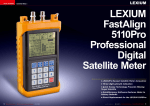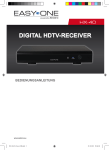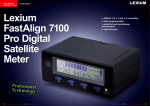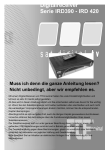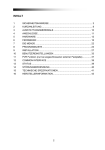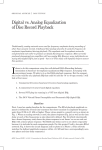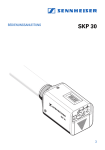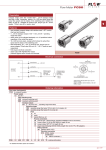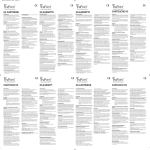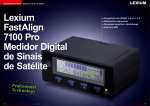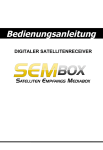Download LEXIUM - TELE-audiovision Magazine
Transcript
TEST REPORT Satellite Meter LEXIUM LEXIUM FastAlign 5110Pro Professional Digital Satellite Meter •LEXIUM’s Newest Satellite Meter Innovation •Three-digit azimuth indication •Quick Sweep Technology Prevents Missing Target Satellite •QuickRecovery Software Restores Meter to Factory Defaults •Direct Replacement for the LEXIUM 5100Pro 74 TELE-satellite International — The World‘s Largest Digital TV Trade Magazine — 09-10/2012 — www.TELE-satellite.com www.TELE-satellite.com — 09-10/2012 — TELE-satellite International — 全球发行量最大的数字电视杂志 75 TEST REPORT LEXIUM Satellite Meter Handheld Powerhouse LEXIUM is quickly becoming a recognized name when it comes to satellite receivers and test equipment. WS International, a global distributor of the most up to date & current DTH (Direct to home) satellite equipment including MPEG2 & MPEG4, DVBS & DVB-S2 equipment has distribution branches based out of Atlanta, Georgia, Los Angeles, California and with sales & development offices in Zhuhai and Guangzhou China markets the LEXIUM brand name world-wide. Just a few months ago, in fact, it was in the 12-01/2012 issue of this magazine, TELE-satellite introduced the LEXIUM FastAlign 7100Pro satellite signal analyzer. The 7100Pro boasted the unique capability of identifying the name of a satellite as soon as the meter showed a lock. The LEXIUM line of digital satellite signal meters, up until recently, also included the FastAlign 5100Pro. With all this going for them, did they feel the need to sit back and relax after these success stories? Did they feel that their job was done? No, not at all. Instead, the engineers went straight back to work. The result of their efforts is the LEXIUM FastAlign 5110Pro. The 5110Pro is actually a direct replacement for their very popular 5100Pro model. Of course, when we 09-10/2012 ■ TELE-satellite Test Editor Ron Roessel aligning a 76cm dish using the new LEXIUM FastAlign 5110Pro Professional Satellite Meter. "It so easy to point the dish with this meter," says Ron Roessel, "and it even makes fun!" 76 TELE-satellite International — The World‘s Largest Digital TV Trade Magazine — 09-10/2012 — www.TELE-satellite.com LEXIUM FastAlign 5110Pro Digital Satellite Meter Helps enormously to install any satellite dish www.TELE-satellite.com/12/09/LEXIUM heard about this new meter, we wanted to find out more about it. If it’s anything like the 7100Pro, then this new meter should be just as exciting, even more so. Once again our friends at WS International provided us with a sample of the FastAlign 5110Pro so that we could have a little fun with it and see what all the fuss is about. The 5110Pro signal meter comes packaged in a nice, small box along with all of its accessories including two battery chargers – one for a wall outlet and another one for the car, two female-to-female “F” type adapters, a USB cable and a handy carrying strap. There’s also a 24-page English-language user manual. So, let’s look at the meter itself. The 5110Pro is a handheld digital signal analyzer that is small enough to fit in one hand. The internal electronics are enclosed in a sturdy black plastic case that is 142 x 82 x 35mm in size. The case itself is encased in a bright yellow rubberized cover that acts as a shock absorber; it will help protect the analyzer if it should ever fall to the ground. The rubberized cover can easily be removed if you ever need to access the battery compartment. At just a hair over 1.0 pound in weight, the meter is very easy to carry around with you wherever you have to go. So, it’s no trouble to climb that ladder to the top of that roof with the 5110Pro hanging on your shoulder; you won’t even know it’s there. The meter sports a pair of male “F” type connectors on the top side of the unit. The connector on the right side is www.TELE-satellite.com — 09-10/2012 — TELE-satellite International — 全球发行量最大的数字电视杂志 77 LEXIUM used to connect to the LNB on the satellite dish. Power to the LNB is supplied by the 5110Pro itself. The manufacturer specifies that the meter should last for about four hours on a single charge and this should be more than enough time for a typical installation. However, if you find that a little more time is needed at the installation site, the meter can also be powered by the satellite receiver. That’s where the second “F” connector on the left side comes in. Ordinarily, the left connector isn’t needed unless supplemental power is needed. The two female-to-female “F” type adapters supplied in the package are used to connect the meter to any existing coax cables. Oddly enough, though, the two male “F” connectors on the meter are not marked in any way on the casing; we had to refer to the user manual in order to figure out which connector did what. There are also no markings for the ports on the bottom of the 5110Pro but in this case it was easy to figure out what they were for just by looking at the type of connector that was being used. On the bottom of the analyzer you’ll find the charging port for the two power adapters (home and car), a USB port to link the meter with a PC and a number of slats behind which is located the meter’s speaker. The front panel of the meter consists of an LCD display and a keyboard. The display is 6.2 x 4.6mm in size and is divided into five different sections. We’ll get more into this a little later. The keyboard is located under the display and is made up of a numerical keypad as well as a number of additional color- ed function buttons. According to the manufacturer, the meter should be fully charged before it’s used for the first time. The charging process should take about four hours but no more than six hours to complete. An LED on the front panel of the analyzer lights up red indicating that the meter is being charged by the external power supply. This LED turns green when the meter is turned on and the power cord is removed. To turn on the 5110Pro, momentarily push the red POWER button on the front panel. If the meter has never been used before, the display will not show any data except for 78 TELE-satellite International — The World‘s Largest Digital TV Trade Magazine — 09-10/2012 — www.TELE-satellite.com LEXIUM 1 zeroes. As mentioned before, the display is divided into five sections: Positioning, Satellite Selection, Channel Number, Latitude and Longitude and Measurement. The Positioning section runs across the top of the display from one side to the other and shows the required azimuth, elevation and polarization angle settings for the target satellite. This section will only display data if you already have entered in your local position and selected the satellite you want to find. The Satellite Selection section on the left side displays information on the currently selected channel (satellite position (L), transponder frequency (F), symbolrate (SR), LNB local oscillator (LO), polarization (LNB) and 22 kHz). The Channel Number section in the lower left hand corner of the display shows the currently 2 3 4 5 6 7 selected channel number either from the “local channel list” or from the “user defined channel list”. The Latitude and Longitude section highlights the location where the meter will be used in degrees latitude and longitude. Also found here are a number of additional function indicators such as battery level, PC link, speaker mute and channel list. The Measurement section displays the signal strength (S) and quality (Q) levels in bar graph form. Additionally, the signal strength (S) is also shown in numerical form as is the signal-to-noise level (S/N) and the bit error rate (B). In order to get the most out of this meter it’s clear that the very first step would be to enter in the local latitude and longitude position where the meter will be used. For our location here in Long Island, New York, it is 41°N 073°W. Only whole numbers can be entered; a more precise location for us would have been 40.7°N 73.3°W but for the purposes of entering in our location in this meter, we had to round to the nearest whole number. Fortunately, this minor limitation should not hamper us in any way when trying to find a specific satellite. Now that our location has been set up, it’s time to see what this meter can do. The 5110Pro comes with a preprogrammed “local channel list” that includes nearly every satellite from around the world. The LEXIUM 5110Pro automatically filters out the satellites that are below the horizon and thus not visible from your location based on the local coordinates that were entered earlier. For our test location the visible satellites (above the horizon) included all those from 80 TELE-satellite International — The World‘s Largest Digital TV Trade Magazine — 09-10/2012 — www.TELE-satellite.com 1. As the antenna was rotated, the signal quality (Q) bar graph clearly shows that we were closing in on GALAXY 19 2. Turning the antenna a little more and “Locked” lit up telling us that we had a signal lock on GALAXY 19 3. Adjusting the dish a little further increased the S/N level until we reached a peak S/N level of 10.1 dB. The dish was now perfectly aligned with GALAXY 19. 4. Next we tried for the HISPASAT satellite at 30°W using the same antenna. As the dish came within range of the target satellite, the 5110Pro showed that we were getting close; the signal quality bar graph (Q) began to react 5. And then moving the antenna just a little bit more…LOCKED! 6. Fine tuning the antenna… 7. …until a maximum S/N level was achieved. The antenna was now peaked on HISPASAT. 139.0°W to 4.8°E for a total of 111 channels to choose from. If you change the location coordinates in the meter, the list of visible satellites changes along with it to adapt to the new location. To give you an LEXIUM idea of how this changes, we changed the local coordinates in the analyzer to 37°N 122°W to simulate the use of the 5110Pro in San Francisco, California. The list of visible satellites for this west coast location included everything from 160°E to 43°W. As you can see, the meter automatically adjusts the local channel list based on its operational location. One thing to keep in mind though: this visible list of satellites represents those satellites that can be “seen” from your location and does not necessarily represent a list of those satellites that can actually be received. Only those satellites that have a beam pointing in your direction can be received. In addition to the “local channel list” there’s also a “user defined channel list”. This list is customizable by the user so that more popular satellites can be accessed more quickly. The 5110Pro comes shipped from the factory without any data in this list. When setting up the “user defined channel list”, the first open channel is selected so that a satellite can be set up. So, let’s say, for example, we wanted to add Galaxy 19 at 97°W into the user defined list. The meter has to first be placed into the “user defined channel list” mode by pressing and holding down the Option/Local button for about three seconds. Once the meter is in the correct mode, you can then enter in all the relevant data for Galaxy 19 (orbital position (L), transponder frequency (F), symbolrate (SR), local oscillator frequency (LO), polarization (LNB) and 22 kHz on/off). For this purpose we chose the 12.177V GHz transponder with a symbolrate of 23000. As soon as the entered data is saved into the meter’s memory, the correct alignment information for the antenna (azimuth, elevation and polarization angle) instantly appears at the top of the display. This data tells you exactly where to point the antenna to receive that satellite. So, with the meter in hand, we went outside to align the dish. Since Galaxy 19 was just entered into the “user defined channel list”, it makes sense to begin by aligning our antenna to this very popular satellite. Keep in mind that you can use either the “user defined channel list” or the “local channel list” to start with since Galaxy 19 also appears in the preprogrammed list. You’ll also need a short piece of coax cable to connect the meter to the antenna’s LNB. And don’t forget the compass so that you know which way to turn the antenna! As it turns out, the 5110Pro is not compatible with any of the DiSEqC protocols so the analyzer needs to be connected directly to the LNB; there cannot be any DiSEqC switches in between the meter and the LNB. As luck would have it, we had a spare 76cm offset dish lying around so we decided to use this antenna to align to GALAXY 19. We installed a standard Ku-band LNBF (LOF = 10.750 GHz) on the dish and connected it to the LEXIUM 5110Pro meter using a short 10-foot piece of coax cable. The meter was turned on and we decided to use the channel data that was just entered into the “user-defined channel list”. We could have also used the preprogrammed data in the “local channel list” (channel 38) that was associated with the Ku-band side of GALAXY 19 at 97°W. This channel was set for 11.789 GHz, 28125 SR, LOF 10.750 GHz and LNB 13 (vertical polarization). Either transponder would have worked for this test. At this point pressing any one of the number buttons (0 to 9) activates the measurement section of the meter. The 5110Pro was set to go; all we had to do is start moving the antenna into roughly the correct position. According to the 5110Pro, the antenna alignment settings yield an azimuth (A) of 214°, an elevation (E) of 36° and a polarization angle (P) of -25°. With the help of our compass, we turned the antenna in the general direction of 214° and elevated it roughly 36° above the horizon. Since our 76cm dish was not on a horizon-to-horizon (H-H) mount, the LNBF had to be rotated inside its holder so that its horizontal and vertical polarization levels matched the position of the GALAXY 19 satellite. We adjusted the position of the LNBF in its mount to reflect the -25° offset suggested by the meter. Thanks to the 5110Pro’s built-in QuickSweep technology you don’t have to worry about missing the target satellite if you turn the antenna too quickly. There is no delay from the time the signal is received to when it is displayed on the meter; it reacts almost instantly. This lets you move 82 TELE-satellite International — The World‘s Largest Digital TV Trade Magazine — 09-10/2012 — www.TELE-satellite.com the antenna much faster than you might otherwise be able to if you were using a different meter. It’s a time saving feature that helps to speed up the alignment process. So, with the meter connected to our 76cm dish and turned on, we rotated the antenna towards 214° while keeping an eye on the 5110Pro. The analyzer also has an audible tone that changes pitch with the signal level. This lets you take your eyes off the meter and listen to changes in signal level if for any reason the display is out of your view. As soon as we approached the 214° position as dictated by the 5110Pro, the signal quality bar graph on the display (Q) began to instantly react. We had found GALAXY 19 on the very first pass! As we continued to move the antenna the signal quality (Q) bar graph continued to increase and the “Locked” indicator on the display illuminated. We continued to move the antenna until we reached a maximum point. We then fine LEXIUM LEXIUM tuned the elevation (E) until a maximum S/N level was achieved. The dish was then secured in place; it couldn’t get any easier than that. Was this just beginners luck? We wanted to make sure so we decided to give the HISPASAT satellite at 30°W a try with the same dish. From the “local channel list” we scrolled through the channels until we found the only entry for 30°W located at channel 86. The entry at this location was for 11.466 GHz, 3500 SR, 9750 LOF. As it turns out, this LEXIUM frequency is not an active frequency for North America. Luckily, changing the existing entry in the “local channel list” to a workable value is a snap. At present, the cursor arrow indicator should be pointing to the channel number (in this case channel 86). By momentarily pushing the Option/Local button on the front panel once, the cursor arrow should move to the frequency position (F) and the first digit in the current frequency should be blinking. Simply enter in the cor- rect transponder frequency using the numerical keypad and then momentarily press the Option/Local button once again to move the arrow cursor to the next entry (SR). For our test we used the 12.052H transponder with a symbolrate of 27500. Continue this procedure until all the remaining parameters are entered and then press the Save/C button to store the data. The LEXIUM 5110Pro is now ready for the HISPASAT satellite. According to the 5110Pro, the proper antenna settings for HISPASAT are an azimuth (A) of 125°, an elevation (E) of 25° and an LNB polarization adjustment (P) of +38°. We repositioned the LNBF in the mount to reflect the new polarization adjustment angle of +38°. Next we loosened the mounting bolts on the antenna so that it could be moved. The antenna was turned towards an azimuth setting of 125° and sure enough as we approached the 125° position the signal quality bar graph (Q) on the meter began to react. As the antenna was moved a little more, the S/N level increased and the “Locked” indicator on the display illuminated. We had found HISPA- 84 TELE-satellite International — The World‘s Largest Digital TV Trade Magazine — 09-10/2012 — www.TELE-satellite.com SAT and once again we found the target satellite on the first pass! Clearly, the LEXIUM 5110Pro’s QuickSweep technology lives up to its name. The meter reacts instantly when you approach the target satellite as you’re turning the antenna. Thanks to this speedy response time, you don’t have to sit there waiting for the analyzer to do its job every time the antenna is moved a notch. You can simply rotate the dish on its mount and stop the rotation when the analyzer reacts to the target satellite. It’s that simple. A note to those of you who will be setting up systems that use universal Ku-band LNBFs: the LEXIUM 5110Pro will work with these types of LNBFs but not exactly in the way that you might expect. When selecting the LOF to be used, you’d undoubtedly expect one of the choices to be “universal” however that is not the case here. With this meter you have to enter the correct universal LOF (9.750 or 10.600 GHz) and set the 22 kHz signal to ON if needed. The correct settings will depend on whether the transponder frequency to be received is in the LNBF’s low band (10.7 to 11.7 GHZ) or high band (11.7 to 12.75 GHz). Of course, the LEXIUM 5110Pro is also C-band compatible. And as if all of the above wasn’t enough, this meter comes with yet another fascinating feature: it has QuickRecovery Software built in. This software restores the 5110Pro back to its original factory settings should a problem ever occur during a data transfer to the meter. In the past such a data transfer interruption would almost always result in a dead meter. Restoring the meter used to involve opening up the case, locating and then reflashing the memory. It’s a process that’s not all that much fun to perform. But thanks to the built-in QuickRecovery software, you don’t have to worry about any of this. Simply press the “Recovery” button to reset the meter back to its original factory settings. How great is that? Earlier we mentioned the USB port located on the bottom of the meter; this port allows you to connect the meter to your PC and gives you the ability to add, delete or modify the satellite list, transponder specifications and 22 kHz settings directly from your PC or laptop. In order to be able to do this, you’d need to download the necessary interface software which can be obtained free of charge by going to www.LEXIUM-dvb.com. The LEXIUM FastAlign 5110Pro digital satellite meter is an extremely powerful signal analyzer wrapped up in a nice little package. It’s a lightweight handheld device that you can easily hold for longer periods of time without any fatigue. It comes with numerous useful features that help make satellite installations a breeze. It comes with a pre-installed list of satellites from all around the world and yet is smart enough to only show those satellites that are visible from your location. It would make the perfect addition to any satellite installer’s toolbox. TECHNICAL DATA ManufacturerLEXIUM California, USA Home Pagewww.LEXIUM-DVB.com [email protected] Model FastAlign 5110Pro Digital Satellite Meter Input Frequency Range 950 – 2150 MHz LNB Power 13V, 18V; 400mA C/Ku-band Compatibleyes Memory 300 channels (local channel list); 100 channels (user defined list) Symbolrate 2 – 45 Ms/sec 22 kHz Controlyes USB Interfaceyes Operating Temperature 0 - 40° C AC Power Supply Input 100 – 240VAC, 1.6A, 50-60Hz; Output 18.5VDC, 3.5A Dimensions 142 x 82 x 35mm Weight 1.0 LBS (including battery) More about this company www.TELE-satellite.com/TELE-satellite-1109/eng/wsinternational.pdf Expert Opinion + Lightweight, easy to use handheld digital satellite signal meter for precise alignment of antenna to target satellite. Its QuickSweep technology takes the worry out of accidentally passing the target satellite while moving the antenna in that the meter reacts instantly to any antenna movements. Its three-digit azimuth display allows this meter to be used anywhere in the world. – No DiSEqC protocols; meter must be connected directly to the LNB without any DiSEqC switches in between. There’s also no universal setting for the LOF; universal LNBFs can be used with this meter but the LOFs need to be set up manually. Ron Roessel TELE-satellite Test Center USA Das Lexium FastAlign 5110 Pro im europäischen Einsatz Thomas Haring Mit dem Lexium FastAlign 5110 Pro hat die US-amerikanische Firma WS International ganz eindeutig nicht nur auf den amerikanischen Markt gezielt, sondern alle Voraussetzungen geschaffen, um ihr neuestes Messgerät auch weltweit vertreiben zu können. Dank der Eingabe der Positionsdaten vor dem ersten Verwenden des Messgeräts ist dieses in der Lage selbstständig zu erkennen, welche Satelliten am aktuellen Standort überhaupt empfangen werden können und welche durch die Erdkrümmung bereits hinter dem Horizont verschwunden sind. Deshalb testeten wir das Lexium FastAlign 5110 Pro auch in Europa in unserem Testcenter in Österreich. Nach der ersten Inbetriebnahme des Lexium FastAlign 5110 Pro haben wir natürlich sofort die Koordinaten hier in Wien/Österreich mit 16° Ost und 48° Nord eingegeben. Kaum hatten wir das erledigt, lieferte uns das FastAlign 5110 Pro auch schon eine vorprogrammierte Satellitenliste die von 58° West bis 92.2° Ost reichte. Damit sind wirklich alle Satelliten abgedeckt, die an unserem Standort theoretisch empfangen werden können. Auf die Beams der einzelnen Satelliten, die z.B. beim östlichsten Satelliten auf 92.2° Ost, dem CHINASAT 9, nur auf China gerichtet sind und einen Empfang am Teststandort Wien daher unmöglich machen, nimmt das neue Lexium Messgerät natürlich keine Rücksicht. Und das ist auch gut so, denn die Ausstrahlungsgebiete eines www.TELE-satellite.com — 09-10/2012 — TELE-satellite International — 全球发行量最大的数字电视杂志 85 LEXIUM Satelliten lassen sich vom Satellitenbetreiber jederzeit verändern und so könnte die eine oder andere asiatische Position in Zukunft auch für einen Europäer interessant werden. Schade, wenn sie dann nicht im Speicher des FastAlign 5110 Pro enthalten wäre. Sehr gut gefallen hat uns, dass Lexium sowohl Transponder im Ku- als auch im C-Band vorprogrammiert hat, denn auch wenn das CBand in Europa nur noch ein Schattendasein fristet, so ist es in anderen Erdteilen immer noch der am häufigsten zur Satellitenübertragung verwendete Frequenzbereich. Insgesamt haben wir 109 vorprogrammierte Satelliteneinträge in unserer Liste vorgefunden, und bevor Sie jetzt nachzählen und zum Ergebnis kommen, dass es in Europa gar nicht so viele empfangbare Positionen gibt, sei Ihnen gesagt: Stimmt, Sie haben recht, aber der Hersteller war so clever bei Satelliten mit Cund Ku-Band Transpondern - wie z.B. dem INTELSAT 14 auf 45° West - diese in zwei getrennten Einträgen abzulegen. Nun ist die gepflegteste Satellitenliste eines Messgeräts trotzdem wertlos, wenn die Transpondereinträge nicht top aktuell und ebenso sorgfältig gewählt sind. Im Test haben wir wahllos etliche europäische Satellitenpositionen getestet und versucht, unsere Antenne mit dem Lexium FastAlign 5110 Pro darauf auszurichten. Dabei fiel uns als erstes auf, dass die vorprogrammierte LOF im High Band auf manchen Satelliten (z.B. ASTRA 4A 4.8° Ost) korrekt mit 10600 vorprogrammiert wurde während bei anderen Satelliten (z.B. BADR 26° Ost) fälschlicherweise 10750 hinterlegt wurde. Hinzu kommt, dass bei keinem der vorprogrammierten Einträge, der das High-Band benutzt, das 22 kHz Signal standardmäßig aktiviert wurde. Der europäische Anwender muss also präzise darauf achten welche Parameter vorprogrammiert wurden und ob diese für den gewünschten Satelliten und das verwendete LNB korrekt sind. Für die meisten europäischen Satelliten hat der Hersteller korrekte Transponderdaten im Speicher des Messgeräts hinterlegt. Insgesamt hat uns das Lexium FastAlign 5110 Pro beim Justieren unserer Antenne sehr gute Dienste geleistet. Dank der einfachen und in- 1 1. Signalmessung auf dem TURKSAT 42° Ost 2. Signalmessung auf dem ASTRA4A 4.8° Ost 3. Signalmessung auf dem EUTELSAT 7A 7° Ost 4. Die vorprogrammierten Transponderdaten auf dem ABS1 75° Ost müssen erst korrigiert werden, um ein Signal zu empfangen:die Polarisation sollte vertikal sein, die LOF ist nicht an das in Europa übliche Universal Ku-Band LNB angepasst (10600) und das 22 kHz Signal ist auch nicht aktiviert. 5. Nachdem wir alle Einstellungen angepasst haben, konnte das Lexium FastAlign 5110 Pro den ABS1 75° Ost perfekt einlesen. tuitiven Bedienung sowie der präzisen Signalmessung wird das Justieren der Antenne zum Kinderspiel. Beim Test mit schwächeren Signalen des BADR 26° Ost oder des ASTRA 2D 28.2° Ost erwies sich der Tuner als eingangsempfindlich und in den Messergebnissen als sehr präzise. Begeistert hat uns die rasche Reaktion des Messgeräts auf Veränderungen beim empfangenen Sig- 2 3 4 5 86 TELE-satellite International — The World‘s Largest Digital TV Trade Magazine — 09-10/2012 — www.TELE-satellite.com nal, so „übersieht“ man beim Ausrichten der Antenne keinen Satelliten mehr. Zusammenfassend hat es uns viel Spaß gemacht, das neue Lexium Messgerät unter europäischen Bedingungen zu testen. Wenn der Hersteller die vorprogrammierte Transponderliste noch einem kleinen Facelift unterzieht, dann gibt es nichts mehr an diesem sehr praktischen Messgerät auszusetzen.







